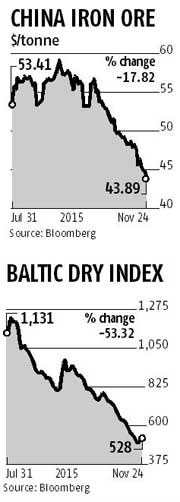India: Iron ore import becomes viable after a gap of three months
Import of iron ore has again become viable, due to a sharp decline in global prices and a steep fall in freight rates over the past three months.
Since their recent peak in August, the price of ore for Chinese delivery has declined 18 per cent, to $43.89 a tonne. The benchmark Baltic Dry Index has fallen 53.3 per cent to 528.
However, domestic iron ore miners, led by government-owned NMDC, have not cut prices proportionately. That of ore lumps are down only 16 per cent since September, to now trade at Rs 2,400 a tonne. Ore fines have seen a negligible decline of six per cent or Rs 100 over three months to Rs 1,560 a tonne.
 “Futures prices are currently at $40 (a tonne) and below for 2016. Also, freight rates have slumped. So, we find domestic ore prices still lagging. The intensity of the fall in global markets is yet to reflect here. In today’s global world, competitiveness is the buzzword and steel mills are getting ore at a more competitive rate. Therefore, it is viable to import until prices here fall in line with global markets,” said Jayant Acharya, director (commercial and marketing), JSW Steel.
“Futures prices are currently at $40 (a tonne) and below for 2016. Also, freight rates have slumped. So, we find domestic ore prices still lagging. The intensity of the fall in global markets is yet to reflect here. In today’s global world, competitiveness is the buzzword and steel mills are getting ore at a more competitive rate. Therefore, it is viable to import until prices here fall in line with global markets,” said Jayant Acharya, director (commercial and marketing), JSW Steel.
Steel mills in India have been importing ore for the past few years since a supply deficit erupted due to the ban on mining imposed by the Supreme Court. In 2014-15, they brought in a record level of 15 million tonnes, after global ore prices hit a historic low of $45 a tonne for the 62 per cent grade. The import slowed after a marginal improvement in global ore prices in August. Also, lower capacity utilisation at steel mills resulted in a substantial fall in ore demand.
As a consequence, the Federation of Indian Mineral Industries (Fimi) forecasts total iron ore import to decline 60 per cent this year to six million tonnes. It says a sharp rise in local production is also a major factor.
“At the current price, import has become viable in Karnataka and other neighbouring states, as transportation from the eastern coast of Odisha becomes costlier than import,” said R K Sharma, secretary-general, Fimi.
A price differential between high and low grades of ore is also a factor for local steel mills. As against the $5-6 a tonne differential between ore lumps and fines in global markets, it works out to $20 a tonne here. Therefore, there is more room for ore price cuts in home markets, to reduce import.
“Indian steel prices are depressed due to onslaught of cheap imports. If the situation on the pricing of ore continues, steel makers will be forced to look for alternatives,” said H Shivramkrishnan, chief commercial officer, Essar Steel.
For the period April to August this year, steel mills and traders imported around 2.8 mt of iron ore. JSW Steel, largest importer last year at 10 mt, has imported barely 700,000 tonnes in the first five months of this financial year. The company might import more, depending on prices in the domestic market and the supply situation in Karnataka. Other importers this year include Tata Steel, Essar Steel and KIOCL, beside private traders.
Iron ore production in this financial year is estimated at 145-150 mt, compared to 129 mt in FY15.
HEADLINES
- Do shipping markets want Biden or Trump for the win?
- All 18 crew safe after fire on Japanese-owned tanker off Singapore
- Singapore launching $44m co-investment initiative for maritime tech start-ups
- Cosco debuts Global Shipping Industry Chain Cooperation Initiative
- US warns of more shipping sanctions
- China continues seaport consolidation as Dalian offer goes unconditional